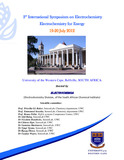| dc.description.abstract | A novel electrochemical biosensor based on 17-β-estradiol (E2)-binding- SELEX-synthesized 76-mer biotinylated aptamer as a molecular recognition element developed on a Poly(propylene thiophenoimine)-co-poly(3,4ethylenedioxythiopene) {Au|G2PPT-co-PEDOT|} dendritic star copolymer modified gold electrode platform via biotin-avidin interaction was constructed for the determination of endocrine disrupting 17-β-estradiol. The nanoelectrode Au|G2PPT-co-PEDOT and the aptasensor (Au|G2PPT-co-PEDOT|ssDNA) were investigated with Fourier transform infra red spectroscopy (FTIR), and fluorescence spectroscopy. The morphology and electrochemical characterization were carried out with scanning electron microscopy (SEM), electrochemical impedance spectroscopy (EIS), cyclic voltammetry (CV) and square wave voltammetry (SWV) respectively. In the measurement of 17-β-estradiol, the interfacial electron transfer of the aptasensor using [Fe(CN)6]-3/-4 redox probe was monitored with cyclic voltammetry(CV) and square wave voltammetry (SWV). The CV and SWV values were measured to evaluate the chemical binding to the aptamer. The biosensor response to 17β-estradiol was based on the decrease in the SWV current as the target binds to the ssDNA aptamer on the biosensor due to the formation of aptamer-complex layer which hindered the free flow of electron from the redox probe to the surface of the electrode as a result of its insulating behavior .The kinetic parameters of the nanoelectrode such as exchange current, heterogeneous rate constant and time constant gave values of 3.01 x 10-4 A, 3.10 x 10-2 cm s-1 and 2.97 x 10-5 s rad-1 compared to the value of 5.18 x 10-5 A, 5.35 x 10-3 cm s-1 and 3.21 x 10-4 s rad-1 obtained for bare gold electrode respectively. The result showed that electron transfer on the nanoelectrode platform was faster than the bare electrode illustrating the catalytic behavior of Au|G2PPT-co-PEDOT. Bode plot showed improved conductivity of the Au|G2PPT-co-PEDOT modified electrode over bare gold electrode with marked reduction in the impedance and phase angle shift from 49° to 11.6°. A dynamic linear range of 0.01 nM to 0.09 nM was observed for the aptasensor (r2=0.999), with a sensitivity of 328 μA/nM and detection limit of 4.10 pM. This work demonstrated that the aptasensor exhibited favorable selectivity, stability, reproducibility for 17-β-estradiol and that Au|G2PPT-co-PEDOT provides a promising platform for immobilization of DNAaptamer. | en |

